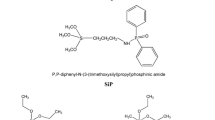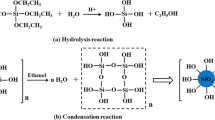Abstract
In this research, a two-component sol–gel inorganic–organic hybrid coating was prepared on a cotton fibre surface. An equimolar sol mixture of the precursors 1H,1H,2H,2H-perfluorooctyltriethoxysilane (SiF) and P,P-diphenyl-N-(3-(trimethoxysilyl)propyl) phosphinic amide (SiP) was applied to cotton fabric samples using the pad-dry-cure method. The surfaces of the untreated and coated cotton fibres were characterised using scanning electron microscopy, Fourier transform-infrared spectroscopy, X-ray photoelectron spectroscopy, and time-of-flight-secondary ion mass spectrometry. The functional properties of the coated cotton fabric samples were investigated using static contact angle measurements with water and n-hexadecane, the ice-releasing test, antibacterial testing against Gram-positive Staphylococcus aureus and Gram-negative Escherichia coli, thermogravimetric analysis in an air atmosphere, and vertical flammability tests. The results reveal the formation of a nanocomposite two-component inorganic–organic hybrid polymer network that is homogenously distributed over the cotton fibre surface. The presence of the SiP component in the two-component inorganic–organic hybrid coating did not hinder the functional properties imparted by the presence of the SiF component and vice versa, illustrating their compatibility. The cooperative action of the SiF and SiP components in the two-component coating provided the cotton fabric with exceptional multifunctionality, including simultaneous superhydrophobicity and high oleophobicity, passive antibacterial activity, and improved thermo-oxidative stability.













Similar content being viewed by others
References
Mahltig B, Böttcher H (2003) Modified silica sol coatings for water-repellent textiles. J Sol–Gel Sci Technol 27:43–52
Mahltig B, Fischer A (2010) Inorganic/organic polymer coatings for textiles to realize water repellent and antimicrobial properties—a study with respect to textile comfort. J Polym Sci B Polym Phys 48:1562–1568
Simončič B, Tomšič B, Černe L, Orel B, Jerman I, Kovač J, Žerjav M, Simončič A (2012) Multifunctional water and oil repellent and antimicrobial properties of finished cotton: influence of sol–gel finishing procedure. J Sol–Gel Sci Technol 61:340–354
Brinker JC, Scherer GW (1990) Sol–gel science: the physics and chemistry of sol–gel processing. Academic Press, San Diego
Castellano M, Gandini A, Fabbri P, Belgacem MN (2004) Modification of cellulose fibres with organosilanes: under what conditions does coupling occur? J Colloid Interface Sci 273:505–511
Salon MCB, Gerbaud G, Abdelmouleh M, Bruzzese C, Boufi S, Belgacem MN (2007) Studies of interactions between silane coupling agents and cellulose fibers with liquid and solid-state NMR. Magn Reson Chem 45:473–483
Vasiljević J, Gorjanc M, Tomšič B, Orel B, Jerman I, Mozetič M, Vesel A, Simončič B (2013) The surface modification of cellulose fibres to create super-hydrophobic, oleophobic and self-cleaning properties. Cellulose 20:277–289
Vilčnik A, Jerman I, Šurca Vuk A, Koželj M, Orel B, Tomšič B, Simončič B, Kovač J (2009) Structural properties and antibacterial effects of hydrophobic and oleophobic sol–gel coatings for cotton fabrics. Langmuir 25:5869–5880
Mahltig B, Haufe H, Böttcher H (2005) Functionalisation of textiles by inorganic sol–gel coatings. J Mater Chem 15:4385–4398
Mahltig B, Audenaert F, Böttcher H (2005) Hydrophobic silica sol coatings on textiles—the influence of solvent and sol concentration. J Sol–Gel Sci Technol 34:103–109
Periolatto M, Ferrero F, Montarsolo A, Mossotti R (2013) Hydrorepellent finishing of cotton fabrics by chemically modified TEOS based nanosol. Cellulose 20:355–364
Yin Y, Wang C (2012) Organic–inorganic hybrid silica film coated for improving resistance to capsicum oil on natural substances through sol–gel route. J Sol–Gel Sci Technol 64:743–749
Basu BJ, Kumar VD, Anandan C (2012) Surface studies on superhydrophobic and oleophobic polydimethylsiloxane–silica nanocomposite coating system. Appl Surf Sci 261:807–814
Lionti K, Toury B, Boissière C, Benayoun S, Miele P (2013) Hybrid silica coatings on polycarbonate: enhanced properties. J Sol–Gel Sci Technol 65:52–60
Sun T, Feng L, Gao X, Jiang L (2005) Bioinspired surfaces with special wettability. Acc Chem Res 38:644–652
Tuteja A, Choi W, McKinley GH, Cohen RE, Rubner MF (2008) Design parameters for superhydrophobicity and superoleophobicity. MRS Bull 33:752–758
Dalvi VH, Rossky PJ (2010) Molecular origins of fluorocarbon hydrophobicity. Proc Natl Acad Sci USA 107:13603–13607
Mino N, Ogawa K, Minoda T, Takatsuka M, Sha S, Moriizumi T (1993) Thin film characteristics of fluorine-substituted monolayers prepared by chemical adsorption from solution. Thin Solid Films 230:209–216
Pintault B, Ayral A (2009) Hydrophobic inorganic membranes for water/gas separation. J Porous Mater 16:73–79
Houde M, De Silva AO, Muir DCG, Letcher RJ (2011) Monitoring of perfluorinated compounds in aquatic biota: an updated review. Environ Sci Technol 45:7962–7973
Lau C, Anitole K, Hodes K, Lai D, Pfahles-Hutchens A, Seed J (2007) Perfluoroalkyl acids: a review of monitoring and toxicological findings. Toxicol Sci 99:366–394
Martin JW, Mabury SA, Solomon KR, Muir DCG (2003) Bioconcentration and tissue distribution of perfluorinated acids in rainbow trout (Oncorhynchus mykiss). Environ Toxicol Chem 22:196–204
Renner R (2001) Growing concern over perfluorinated chemicals. Environ Sci Technol 35:154A
Tomšič B, Simončič B, Orel B, Černe L, Forte Tavčer P, Zorko M, Jerman I, Vilčnik A, Kovač J (2008) Sol–gel coating of cellulose fibres with antimicrobial and repellent properties. J Sol–Gel Sci Technol 47:44–57
Farhadi S, Farzaneh M, Kulinich SA (2011) Anti-icing performance of superhydrophobic surfaces. Appl Surf Sci 257:6264–6269
Hejazi V, Sobolev K, Nosonovsky M (2013) From superhydrophobicity to icephobicity: forces and interaction analysis. Sci Rep 3:2194
Meuler AJ, Smith JD, Varanasi KK, Mabry JM, McKinley GH, Cohen RE (2010) Relationships between water wettability and ice adhesion. ACS Appl Mater Interfaces 2:3100–3110
Zou M, Beckford S, Wei R, Ellis C, Hatton G, Miller MA (2011) Effects of surface roughness and energy on ice adhesion strength. Appl Surf Sci 257:3786–3792
Alongi J, Colleoni C, Malucelli G, Rosace G (2012) Hybrid phosphorus-doped silica architectures derived from a multistep sol–gel process for improving thermal stability and flame retardancy of cotton fabrics. Polym Degrad Stab 97:1334–1344
Alongi J, Colleoni C, Rosace G, Malucelli G (2013) The role of pre-hydrolysis on multi step sol–gel processes for enhancing the flame retardancy of cotton. Cellulose 20:525–535
Hu S, Hu Y, Song L, Lu H (2011) Effect of modified organic–inorganic hybrid materials on thermal properties of cotton fabrics. J Therm Anal Calorim 103:423–427
Hu S, Hu Y, Song L (2012) The potential of functionalized organic–inorganic hybrid materials for influencing the thermal stability of cotton fabrics. Sci Adv Mater 4:985–993
Vasiljević J, Hadžić S, Jerman I, Černe L, Tomšič B, Medved J, Godec M, Orel B, Simončič B (2013) Study of flame-retardant finishing of cellulose fibres: organic–inorganic hybrid versus conventional organophosphonate. Polym Degrad Stab. doi:10.1016/j.polymdegradstab.2013.09.020
Yang Z, Fei B, Wang X, Xin JH (2012) A novel halogen-free and formaldehyde-free flame retardant for cotton fabrics. Fire Mater 36:31–39
Bonnet J, Bounor-Legaré V, Boisson F, Melis F, Camino G, Cassagnau P (2012) Phosphorus based organic–inorganic hybrid materials prepared by reactive processing for EVA fire retardancy. Polym Degrad Stab 97:513–522
Qian X, Song L, Hu Y, Yuen RKK (2012) Preparation and thermal properties of novel organic/inorganic network hybrid materials containing silicon and phosphate. J Polym Res 19:9890
Tang Z, Li Y, Zhang YJ, Jiang P (2012) Oligomeric siloxane containing triphenylphosphonium phosphate as a novel flame retardant for polycarbonate. Polym Degrad Stab 97:638–644
Horrocks AR, Price D (2001) Fire retardant materials. Woodhead Publishing Limited, Cambridge
Horrocks AR (1983) An introduction to the burning behaviour of cellulosic fibres. J Soc Dye Colour 99:191–197
Zhu P, Sui S, Wang B, Sun K, Sun G (2004) A study of pyrolysis and pyrolysis products of flame-retardant cotton fabrics by DSC, TGA, and PY–GC–MS. J Anal Appl Pyrolysis 71:645–655
Kandola BK, Horrocks AR, Price D, Coleman GV (1996) Flame-retardant treatments of cellulose and their influence on the mechanism of cellulose pyrolysis. J Macromol Sci Polym Rev 36:721–794
Gaan S, Sun G (2007) Effect of phosphorus flame retardants on thermo-oxidative decomposition of cotton. Polym Degrad Stab 92:968–974
Horrocks AR, Price D, Akalin M (1996) FTIR analysis of gases evolved from cotton and flame retarded cotton fabrics pyrolysed in air. Polym Degrad Stab 52:205–213
Gaan S, Sun G, Hutches K, Engelhard MH (2008) Effect of nitrogen additives on flame retardant action of tributyl phosphate: phosphorus-nitrogen synergism. Polym Degrad Stab 93:99–108
Colleoni C, Donelli I, Freddi G, Guido E, Migani V, Rosace G (2013) A novel sol–gel multi-layer approach for cotton fabric finishing by tetraethoxysilane precursor. Surf Coat Technol 235:192–203
Alongi J, Malucelli G (2013) Heat and moisture transfer in sol–gel treated cotton fabrics. J Therm Anal Calorim 111:459–465
Wu W, Yang CQ (2007) Comparison of different reactive organophosphorus flame retardant agents for cotton. Part II: fabric flame resistant performance and physical properties. Polym Degrad Stab 92:363–369
Simončič B, Hadžić S, Vasiljević J, Černe L, Tomšič B, Jerman I, Orel B, Medved J (2013) Tailoring of multifunctional cellulose fibres with “lotus effect” and flame retardant properties. Cellulose. doi:10.1007/s10570-013-0103-4
Černe L, Hadžić S, Simončič B (2013) Determination of optimal concentrations of agents for preparation of multifunctional water and oil repellent and flame retardant finish. Tekstilec 56:13–21
Horrocks AR (2011) Flame retardant challenges for textiles and fibres: new chemistry versus innovatory solutions. Polym Degrad Stab 96:377–392
Hd’A Heck, Casanova M (2004) The implausibility of leukemia induction by formaldehyde: a critical review of the biological evidence on distant-site toxicity. Regul Toxicol Pharmacol 40:92–106
Lam Y-L, Kan C-W, Yuen C-WM (2012) Developments in functional finishing of cotton fibres–wrinkle-resistant, flame-retardant and antimicrobial treatments. Text Prog 44:175–249
Weil ED, Levchik SV (2008) Flame retardants in commercial use or development for textiles. J Fire Sci 26:243–281
Alongi J, Malucelli G (2012) State of the art and perspectives on sol–gel derived hybrid architectures for flame retardancy of textiles. J Mater Chem 22:21805–21809
Moulder JF, Stickle WF, Sobol PE, Bomben KD (1995) Handbook of X-ray photoelectron spectroscopy. Physical Electronics Inc., Eden Prairie
Lee HJ (2012) Design and development of anti-icing textile surfaces. J Mater Sci 47:5114–5120
Hulleman SHD, van Hazendonk JM, van Dam JEG (1994) Determination of crystallinity in native cellulose from higher plants with diffuse reflectance Fourier transform infrared spectroscopy. Carbohydr Res 261:163–172
Tomšič B, Simončič B, Orel B, Vilčnik A, Spreizer H (2007) Biodegradability of cellulose fabric modified by imidazolidinone. Carbohydr Polym 69:478–488
Lenk TJ, Hallmark VM, Hoffmann CL, Rabolt JF, Castner DG, Erdelen C, Ringsdorf H (1994) Structural investigation of molecular organization in self-assembled monolayers of a semifluorinated amidethiol. Langmuir 10:4610–4617
Rabolt JF, Russell TP, Twieg RJ (1984) Structural studies of semifluorinated n-alkanes. 1. Synthesis and characterization of F(CF2)n(CH2)mH in the solid state. Macromolecules 17:2786–279463
Socrates G (2001) Infrared and raman characteristic group frequencies: tables and charts. Wiley, Chichester
Orel B, Jese R, Vilčnik A, Štangar UL (2005) Hydrolysis and solvolysis of methyltriethoxysilane catalyzed with HCl or trifluoroacetic acid: IR spectroscopic and surface energy studies. J Sol–Gel Sci Technol 34:251–265
Abidi N, Cabrales L, Haigler CH (2014) Changes in the cell wall and cellulose content of developing cotton fibers investigated by FTIR spectroscopy. Carbohydr Polym 100:9–16
Chung C, Lee M, Choe EK (2004) Characterization of cotton fabric scouring by FT-IR ATR spectroscopy. Carbohydr Polym 58:417–420
Berman ESF, Kulp KS, Knize MG, Wu L, Nelson EJ, Nelson DO, Wu KJ (2006) Distinguishing monosaccharide stereo- and structural isomers with TOF-SIMS and multivariate statistical analysis. Anal Chem 78:6497–6503
Deslandes Y, Pleizier G, Poiré E, Sapieha S, Wertheimer MR, Sacher E (1998) The surface modification of pure cellulose paper induced by low-pressure nitrogen plasma treatment. Plasmas Polym 3:61–76
Goacher RE, Jeremic D, Master ER (2011) Expanding the library of secondary ions that distinguish lignin and polysaccharides in time-of-flight secondary ion mass spectrometry analysis of wood. Anal Chem 83:804–812
Acknowledgments
This work was supported by the Slovenian Research Agency (Programme P2-0213 and a Grant for the Ph.D. student J. V.).
Author information
Authors and Affiliations
Corresponding author
Rights and permissions
About this article
Cite this article
Vasiljević, J., Tomšič, B., Jerman, I. et al. Multifunctional superhydrophobic/oleophobic and flame-retardant cellulose fibres with improved ice-releasing properties and passive antibacterial activity prepared via the sol–gel method. J Sol-Gel Sci Technol 70, 385–399 (2014). https://doi.org/10.1007/s10971-014-3294-8
Received:
Accepted:
Published:
Issue Date:
DOI: https://doi.org/10.1007/s10971-014-3294-8




